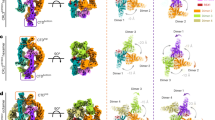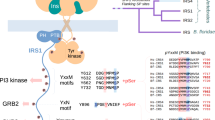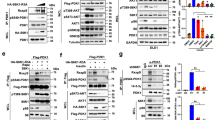Abstract
Protein-tyrosine phosphatase 1B (PTP1B) is an ubiquitously expressed enzyme that negatively regulates growth-factor signalling and cell proliferation by binding to and dephosphorylating key receptor tyrosine kinases, such as the insulin receptor1. It is unclear how the activity of PTP1B is regulated. Using a yeast two-hybrid assay, a protein inhibitor of activated STAT1 (PIAS1)2 was isolated as a PTP1B-interacting protein. Here, we show that PIAS1, which functions as a small ubiquitin-like modifier (SUMO) E3 ligase, associates with PTP1B in mammalian fibroblasts and catalyses sumoylation of PTP1B. Sumoylation of PTP1B reduces its catalytic activity and inhibits the negative effect of PTP1B on insulin receptor signalling and on transformation by the oncogene v-crk. Insulin-stimulated sumoylation of endogenous PTP1B results in a transient downregulation of the enzyme; this event does not occur when the endogenous enzyme is replaced with a sumoylation-resistant mutant of PTP1B. These results suggest that sumoylation, which has been implicated primarily in processes in the nucleus and nuclear pore, also modulates a key enzyme–substrate signalling complex that regulates metabolism and cell proliferation.
This is a preview of subscription content, access via your institution
Access options
Subscribe to this journal
Receive 12 print issues and online access
$209.00 per year
only $17.42 per issue
Buy this article
- Purchase on SpringerLink
- Instant access to full article PDF
Prices may be subject to local taxes which are calculated during checkout





Similar content being viewed by others
References
Bourdeau, A., Dube, N. & Tremblay, M. L. Cytoplasmic protein tyrosine phosphatases, regulation and function: the roles of PTP1B and TC-PTP. Curr. Opin. Cell Biol. 17, 203–209 (2005).
Kotaja, N., Karvonen, U., Janne, O. A. & Palvimo, J. J. PIAS proteins modulate transcription factors by functioning as SUMO-1 ligases. Mol. Cell Biol. 22, 5222–5234 (2002).
Liu, F., Hill, D. E. & Chernoff, J. Direct binding of the proline rich region of protein tyrosine phosphatase 1B to the src homology 3 domain of p130Cas. J. Biol. Chem. 271, 31290–31295 (1996).
Goldstein, B. J., Bittner-Kowalczyk, A., White, M. F. & Harbeck, M. Tyrosine dephosphorylation and deactivation of insulin receptor substrate-1 by protein-tyrosine phosphatase 1B. Possible facilitation by the formation of a ternary complex with the Grb2 adaptor protein. J. Biol. Chem. 275, 4283–4289 (2000).
Cheng, A., Bal, G. S., Kennedy, B. P. & Tremblay, M. L. Attenuation of adhesion-dependent signaling and cell spreading in transformed fibroblasts lacking protein tyrosine phosphatase-1B. J. Biol. Chem. 276, 25848–25855 (2001).
Takino, T. et al. Tyrosine phosphorylation of the CrkII adaptor protein modulates cell migration. J. Cell Sci. 116, 3145–3155 (2003).
Golemis, E. A., Gyuris, J. & Brent, R. in Interaction Trap/Two-Hybrid system to identify interacting proteins. (eds Ausubel, F. M. et al.) (John Wiley and Sons, New York, 1994).
Haj, F. G., Markova, B., Klaman, L. D., Bohmer, F. D. & Neel, B. G. Regulation of receptor tyrosine kinase signaling by protein tyrosine phosphatase-1B. J. Biol. Chem. 278, 739–744 (2003).
Sachdev, S. et al. PIASy, a nuclear matrix-associated SUMO E3 ligase, represses LEF1 activity by sequestration into nuclear bodies. Genes Dev. 15, 3088–3103 (2001).
Li, S. J. & Hochstrasser, M. A new protease required for cell-cycle progression in yeast. Nature 398, 246–251 (1999).
Bylebyl, G. R., Belichenko, I. & Johnson, E. S. The SUMO isopeptidase Ulp2 prevents accumulation of SUMO chains in yeast. J. Biol. Chem. 278, 44113–44120 (2003).
Johnson, E. S. Protein modification by SUMO. Annu. Rev. Biochem. 73, 355–382 (2004).
Kim, Y. H. et al. Desumoylation of homeodomain-interacting protein kinase 2 (HIPK2) through the cytoplasmic-nuclear shuttling of the SUMO-specific protease SENP1. FEBS Lett 579, 6272–6278 (2005).
Liu, B. et al. PIAS1 selectively inhibits interferon-inducible genes and is important in innate immunity. Nature Immunol. 5, 891–898 (2004).
Frangioni, J. V., Beahm, P. H., Shifrin, V., Jost, C. A. & Neel, B. G. The nontransmembrane tyrosine phosphatase PTP-1B localizes to the endoplasmic reticulum via its amino acid C-terminal sequence. Cell 68, 545–560 (1992).
Woodford-Thomas, T. A., Rhodes, J. D. & Dixon, J. E. Expression of a protein tyrosine phosphatase in normal and v-src-transformed mouse 3T3 fibroblasts. J. Cell. Biol. 117, 401–414 (1992).
Pichler, A., Gast, A., Seeler, J. S., Dejean, A. & Melchior, F. The nucleoporin RanBP2 has SUMO1 E3 ligase activity. Cell 108, 109–120 (2002).
Saitoh, N. et al. In situ SUMOylation analysis reveals a modulatory role of RanBP2 in the nuclear rim and PML bodies. Exp. Cell Res. 312, 1418–1430 (2006).
Ng, T. et al. Imaging PKC-α activation in cells. Science 283, 2085–2089 (1999).
Ganesan, S., Ameer-beg, S. M., Ng, T. T. C., Vojnovic, B. & Wouters, F. S. A dark yellow fluorescent protein (YFP)-based Resonance Energy-Accepting Chromoprotein (REACh) for Forster resonance energy transfer with GFP. Proc. Natl Acad. Sci. USA 103, 4089–4094 (2006).
Zhao, Y., Kwon, S. W., Anselmo, A., Kaur, K. & White, M. A. Broad spectrum identification of cellular small ubiquitin-related modifier (SUMO) substrate proteins. J. Biol. Chem. 279, 20999–1002 (2004).
Melchior, F. SUMO — nonclassical ubiquitin. Annu. Rev. Cell Dev. Biol. 16, 591–626 (2000).
Wiesmann, C. et al. Allosteric inhibition of protein tyrosine phosphatase 1B. Nature Struct. Mol. Biol. 11, 730–737 (2004).
Uchimura, Y., Nakamura, M., Sugasawa, K., Nakao, M. & Saitoh, H. Overproduction of eukaryotic SUMO-1- and SUMO-2-conjugated proteins in Escherichia coli. Anal. Biochem. 331, 204–206 (2004).
Dadke, S. & Chernoff, J. Protein-tyrosine phosphatase 1B mediates the effects of insulin on the actin cytoskeleton in immortalized fibroblasts. J. Biol. Chem. 278, 40607–40611 (2003).
Liu, F. & Chernoff, J. Suppression of oncogene-mediated transformation of rat 3Y1 fibroblasts by protein tyrosine phosphatase 1B requires a functional SH3-ligand. Mol. Cell. Biol. 18, 250–259 (1998).
Campbell, R. E. et al. A monomeric red fluorescent protein. Proc. Natl Acad. Sci. USA 99, 7877–7882 (2002).
Hubbard, S. R. Crystal structure of the activated insulin receptor tyrosine kinase in complex with peptide substrate and ATP analog. EMBO J. 16, 5572–5581 (1997).
Peter, M. et al. Multiphoton-FLIM quantification of the EGFP-mRFP1 FRET pair for localization of membrane receptor-kinase interactions. Biophys J. 88, 1224–1237 (2005).
Acknowledgements
We thank V. Guacci, A. Kikuchi, S. Michaelis, J. Palvimo, M. White and H. Yokosawa for their gifts of reagents, and D. Dadke for her assistance. This work was supported by grants from the National Institutes of Health (B.G.N., K.S. and J.C), an endowment fund from the Richard Dimbleby Cancer Fund to King's College London (T.N.), a National Cancer Institute CORE grant to the Fox Chase Cancer Center, and an appropriation from the Commonwealth of Pennsylvania. The multiphoton FLIM system was built with support from both the Medical Research Council Co-Operative Group grant (G0100152 ID 56891) and an UK Research Councils Basic Technology Research Programme grant (GR/R87901/01).
Author information
Authors and Affiliations
Contributions
S.D. and J.C. conceived the project and prepared most of the manuscript. S.D., S.C., S.-C.Y. and Z.M.J. performed the biochemical and cellular analyses. T.N. carried out the FLIM experiments shown in Fig. 2. F.H., A.I., F.R., K.S. and B.G.N. provided key reagents, cell lines and/or advice.
Corresponding author
Ethics declarations
Competing interests
The authors declare no competing financial interests.
Supplementary information
Supplementary Information
Supplementary figures S1, S2, S3 and S4 (PDF 265 kb)
Rights and permissions
About this article
Cite this article
Dadke, S., Cotteret, S., Yip, SC. et al. Regulation of protein tyrosine phosphatase 1B by sumoylation. Nat Cell Biol 9, 80–85 (2007). https://doi.org/10.1038/ncb1522
Received:
Accepted:
Published:
Issue Date:
DOI: https://doi.org/10.1038/ncb1522



